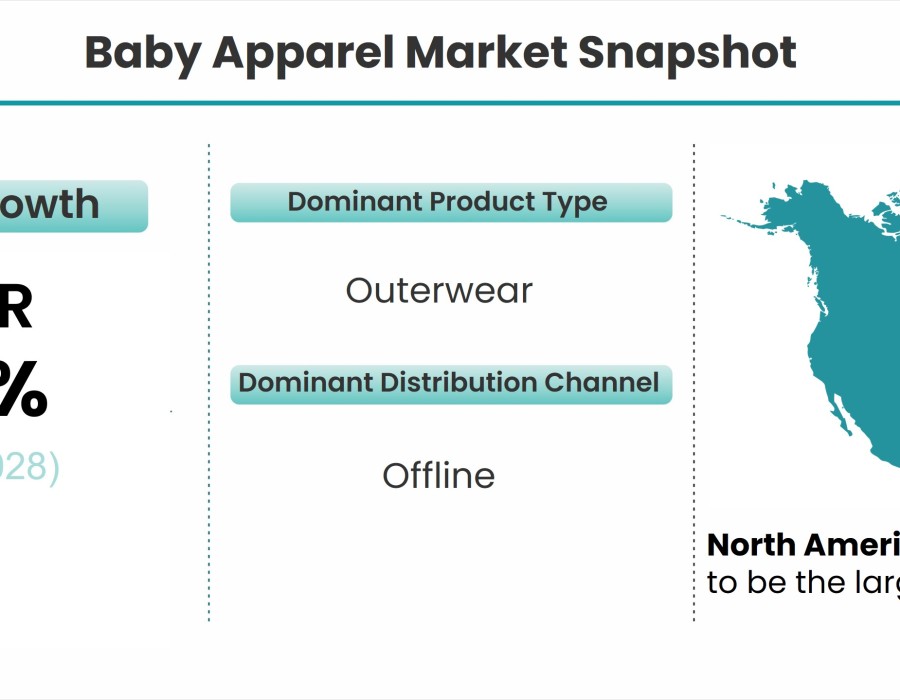As awareness of environmental issues grows, many parents are looking for sustainable and eco-friendly options for their little ones, including baby clothing. Sustainable baby clothing not only helps protect the planet but also ensures that the garments are safe and gentle on a baby’s delicate skin. This article explores various eco-friendly options for baby clothing, the benefits of choosing sustainable materials, and tips for selecting the best items for your baby.
According to Stratview Research, the baby apparel market is likely to grow with a healthy CAGR of 5.4% during the forecast period.
Benefits of Sustainable Baby Clothing
Health and Safety: Sustainable baby clothing is typically made from organic materials that are free from harmful chemicals and toxins. Conventional baby clothing often contains pesticides, synthetic dyes, and other chemicals that can irritate a baby's sensitive skin. Organic fabrics, such as organic cotton, bamboo, and hemp, are grown without the use of synthetic pesticides and fertilizers, reducing the risk of allergies and skin irritations.
Environmental Impact: Choosing sustainable baby clothing helps reduce the environmental footprint associated with textile production. Organic farming practices use less water, produce fewer greenhouse gases, and avoid the use of toxic chemicals that can harm soil and water quality. Additionally, sustainable baby clothing often involves more eco-friendly manufacturing processes that minimize waste and energy consumption.
Ethical Production: Many sustainable baby clothing brands prioritize fair trade practices, ensuring that workers receive fair wages and work in safe conditions. By supporting these brands, parents can contribute to more ethical and socially responsible production practices.
Eco-Friendly Fabrics for Baby Clothing
Organic Cotton: Organic cotton is one of the most popular choices for sustainable baby clothing. It is grown without synthetic pesticides or fertilizers, making it safer for both the environment and your baby’s skin. Organic cotton is soft, breathable, and durable, making it ideal for baby clothes.
Bamboo: Bamboo fabric is another excellent option for eco-friendly baby clothing. Bamboo grows quickly and requires minimal water and no pesticides, making it a highly sustainable crop. Bamboo fabric is naturally hypoallergenic, antibacterial, and incredibly soft, providing comfort for your baby.
Hemp: Hemp is a versatile and sustainable fabric that is gaining popularity in the baby clothing market. It grows rapidly, requires little water, and improves soil health. Hemp fabric is strong, breathable, and becomes softer with each wash, making it a durable and comfortable choice for baby clothes.
Tencel (Lyocell): Tencel is an eco-friendly fabric made from sustainably sourced wood pulp, typically from eucalyptus trees. The production process for Tencel uses a closed-loop system that recycles water and solvents, reducing environmental impact. Tencel fabric is soft, breathable, and moisture-wicking, making it perfect for baby clothing.
Tips for Choosing Sustainable Baby Clothing
Check Certifications: Look for certifications such as Global Organic Textile Standard (GOTS), OEKO-TEX Standard 100, and Fair Trade Certified. These certifications ensure that the fabrics and production processes meet high standards for sustainability and safety.
Prioritize Quality: High-quality sustainable baby clothing may have a higher upfront cost but will last longer, making it a more cost-effective choice in the long run. Durable clothes can also be passed down to younger siblings or donated, reducing waste.
Choose Timeless Designs: Opt for classic and versatile designs that can be easily mixed and matched. Timeless styles are less likely to go out of fashion, making them suitable for longer use.
Support Ethical Brands: Research and support brands that prioritize sustainability, ethical production practices, and transparency. Many eco-friendly baby clothing brands have a strong commitment to social and environmental responsibility.
Consider Second-Hand Options: Buying second-hand baby clothing is another sustainable option. Gently used baby clothes can often be found in excellent condition and at a lower cost. This practice extends the life of the garments and reduces the demand for new production.
Conclusion
Sustainable baby clothing offers numerous benefits for both your little one and the planet. By choosing eco-friendly fabrics like organic cotton, bamboo, hemp, and Tencel, parents can ensure their baby’s clothes are safe, comfortable, and environmentally responsible. Additionally, supporting ethical brands and making mindful purchasing decisions contribute to a more sustainable and fair textile industry. As more parents embrace the importance of sustainability, the demand for eco-friendly baby clothing will continue to grow, paving the way for a healthier future for our children and the planet.






Comments